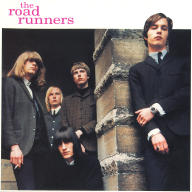The Roadrunners were part of the second wave of Liverpool beat bands, formed in Birkenhead in the wake of groups like the Big Three and younger first-wave bands like the Beatles and the Searchers. The group members had originally gotten together as the Tenabeats in 1961 or early 1962, with Dave Percy on lead guitar and vocals. The group's real star after they renamed themselves the Roadrunners, however, was Mike Hart, an architecture student with a great voice. Pete Mackey played bass and also sang, John Peacock was the group's pianist, and Dave Boyce played drums. Sometime between 1961 and 1963, Dave Percy exited the group's lineup, leaving the core of the group as a quartet.
In contrast to a lot of their contemporaries, the Roadrunners played more rhythm & blues than rock & roll, and they became frequent performers at the Cavern Club, often on the same billing with the Beatles -- indeed, they were on the same bill as the Beatles on the latter group's final engagement there. The Roadrunners played and sang American R&B like they meant it, and were extremely popular both in Liverpool and Hamburg, where they won a competition at the Star-Club and could have made a major name for themselves. Indeed, George Harrison, when asked once about the Rolling Stones early in the climb to fame by the latter band, remarked that Mick Jagger, Brian Jones, and company were about as good as the Roadrunners, and he meant it as a compliment to the London band.
The Roadrunners were also out in front of the Rolling Stones in some respects, covering Arthur Alexander's You Better Move On before the Stones put their rendition on tape for anyone to hear. They could also rock out on Bo Diddley and Chuck Berry numbers as well as any band in England, romping and stomping over songs like Beautiful Delilah and (natch!) Roadrunner like they'd invented them, the latter being an especially fine showcase for their work.
What they didn't do, of course, was write songs, and this limited their appeal -- exciting as their records and stage act were -- as more and more of the competition, especially the likes of the Rolling Stones, began coming up with original numbers that had their own twists on American R&B. Getting airplay on covers -- however good they might have been -- of American songs was a dicey prospect at best for any Northern act at the outset of the beat boom in Liverpool, and became tougher as original songs became the norm in the mid-'60s. If anything else held the Roadrunners back, it was the fact that singer/guitarist Mike Hart refused to give up his architecture studies, and that, as a result, he was only able to go abroad with the band during semester breaks. This limited their prospects even in Germany, where they could have made a good living. Still, their reputation was such that the group played the first Birmingham RB Festival -- produced and recorded by Giorgio Gomelsky -- on a bill with the Spencer Davis RB Quartet, the Steampacket, Long John Baldry the Hoochie Coochie Men, the Yardbirds, and Sonny Boy Williamson II.
There was even some interest for a time from Decca Records, which was quite a compliment considering that they already had the Stones under contract and were looking at groups like the Small Faces. Hart, however, became wary of the overtures and what they would mean in terms of softening the group's sound. The group never made the jump to international success that those other bands (or their key members) did, but not for lack of trying. In 1964, the group's lineup expanded with the addition of pair of saxophone players, Nick Carver and John Phillips (who also played the flute), who later was a part of the Eyes, a Liverpool-spawned outfit that also featured Klaus Voormann. The group recorded a live album at the Star-Club, released under the auspices of Ariola Records, which showed an evolution in their sound -- where the group had started out under the influence of Muddy Waters and Howlin' Wolf, by late 1963 the Roadrunners were showing the influence of James Brown and Bobby Bland, as well as Arthur Alexander and Larry Williams. The band had a formidable sound, and at his best Mike Hart was a near match for Mick Jagger or Eric Burdon as a soul singer.
Their big break never came, however -- at least, not outside of Germany. A second Star-Club album, shared with the group Shorty Them, appeared in 1965. But by the middle of that year the lineup had begun to crack, Phillips having moved on (succeeded by Bob Harrison on trumpet) and Mike Hart finally exited the group. He joined the Liverpool Scene and was succeeded in the Roadrunners by Mike Byrne on vocals and Mike Kontzle on guitar, while Terry McCusker took over on the drums from Dave Boyce. The group played out its string in Germany under Peter Mackey's leadership into early 1966 before disbanding. Mackey and Hart later joined forces in an attempt to start Hart on a solo recording career. In 1999, Bear Family Records reissued the Roadrunners Star-Club album as part of its four-CD set Die Ariola Star-Club Aufnahmen. Mike Byrne started a Beatles museum in Liverpool in the 1980s. ~ Bruce Eder, Rovi

















